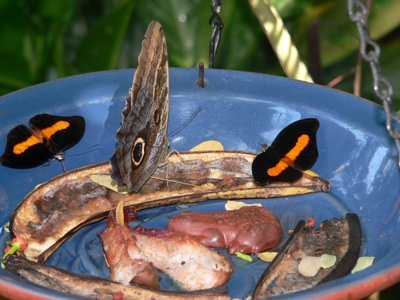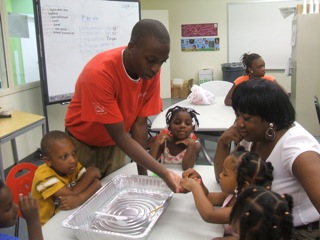 |
Support for scijourner.org comes from National Science Foundation grant number DRL-0822354 |
| University of Missouri-Saint Louis and its College of Education , |
|
 |
and the Saint Louis Science Center and its Youth Exploring Science program |
 |
Support for scijourner.org comes from National Science Foundation grant number DRL-0822354 |
| University of Missouri-Saint Louis and its College of Education , |
|
 |
and the Saint Louis Science Center and its Youth Exploring Science program |
“Do you live to eat, or do you eat to live?” asks Youth Exploring Science (YES) Supervisor Joshua Sams. Think of a wonderful McDonald’s lunch a cheeseburger, medium French fries, a medium drink, and an apple pie compared to the typical YES lunch of a ham or turkey sandwich. Which one would you prefer?
 Diabetes, high blood pressure, clogged arteries, and obesity are just a few of the major health risks, according to kidshealth.org, that today’s youth face when they put fast food like a McDonald’s lunch in their tummies everyday. According to the Centers for Disease Control, the current generation is the youngest group of people to have such severe health problems. But are there better choices to make when picking a lunch?
Diabetes, high blood pressure, clogged arteries, and obesity are just a few of the major health risks, according to kidshealth.org, that today’s youth face when they put fast food like a McDonald’s lunch in their tummies everyday. According to the Centers for Disease Control, the current generation is the youngest group of people to have such severe health problems. But are there better choices to make when picking a lunch?
At the Taylor Community Science Resource Center, lunch consists of a turkey and ham sandwich with American cheese, miracle whip, a small bag of chips, a juice box, and an apple or the teens can go to the local stores or fast food restaurants. According to YES Supervisor Joshua Sims, the lunch is served to about 15 to 100 teens on average, which results in about 80 sandwiches being made and eaten per day (excluding those that just eat chips or drink a juice box).
A McDonald’s lunch has 1050 calories, 44 grams of fat, 1195 milligrams of sodium, according to McDonald’s website. On the other hand, a lunch with turkey at the Taylor Center contains 650 calories, 20.5 grams of fat and 1455 milligrams of sodium, according to information on food labels. Replace the turkey with ham and the lunch has 660 calories, 21.5 grams of fat and 1455 milligrams of sodium. Which is a 400 and 410-calorie difference, and a bonus is that the lunch at the Taylor Center is free unlike the $6 or $7 you might spend everyday going out to eat. KiOntey Turner
 If you are thinking of getting a tattoo it’s important to get the facts. Tattoos can be marvelous works of art that symbolize something or someone in your life, but are there any health risks?
If you are thinking of getting a tattoo it’s important to get the facts. Tattoos can be marvelous works of art that symbolize something or someone in your life, but are there any health risks?
According to Shaun Oldershaw, there are very few risks from getting a tattoo as long as a professional does them. Oldershaw is a tattoo artist at Cheap Trx on Grand Avenue in Saint Louis, and has been tattooing for nearly eight years.
Minor risks include allergic reactions to latex in the surgical gloves or to pigments of the tattoo ink, says Oldershaw. “Allergic reactions are pretty much person to person.”
However, you might run into more serious trouble if you go to “scratchers”. A scratcher is a tattoo artist’s term for a nonprofessional who performs tattoos out of their own houses. Those are the people spreading disease, if not just doing bad work, states Oldershaw.
If you go to a scratcher you run the risk of getting hepatitis. As far as getting HIV from tattooing, well its sort of a myth claims Oldershaw.
Centers for Disease Control does declare that the risk still exists in getting HIV from tattoos.
Oldershaw says there are simple ways to deal with the allergic problems in his shop. For example, nitrile rather than latex gloves can be used to avoid latex allergies.
Red ink is usually the pigment that is the most hazardous for allergic reactions, says Oldershaw. Pigments can cause an allergic reaction to the skin in different ways. For some the skin might just completely reject the ink, while others will just be irritated and take longer to heal.
“There’s an occasional person who has an allergic reaction to the ink or a rough feel. Touch ups here are free,” says Oldershaw.
Like other professionals, Oldershaw has to have a license. The Missouri Office of Tattooing, Body piercing and Branding licenses Oldershaw. Occasionally, an inspector from the office comes to check if everything is clean and going right, he adds.
Oldershaw says that if you are looking to get a tattoo, inspect the artist’s portfolio to see if it’s the style you are looking for. Look around the shop, see if they have barrier film on everything and bags on bottles, and that things don’t have a chance of cross contamination. “Make sure the shop has a clean room,” adds Oldershaw. Most tattoo places use autoclaves as a way to sterilize needles, but since everything comes prepackaged it is not necessary.
At any age people get tattoos. Most get tattoos in their 20,s or 30’s. “I’ve tattooed people that are 80,” says Oldershaw. Just remember its permanent.

This work is licensed under a Creative Commons Attribution-NonCommercial-NoDerivs 3.0 Unported License
Could you see yourself having a high paying career where you can dress casually? Cheryl Ellis from HEC-TV could.
Ellis has been an employee with HEC-TV (Higher Education Channel Television)—St. Louis’s education, arts, and culture station—for 8 years, but has been working in the field for 25 years. 
She actually started her TV career as a secretary. Ellis became interested in the behind-the-scenes work of a TV station. So, when a position opened up, she moved to the production room. After working there for a while, she was given responsibility for handling the station’s master control “I saw that you could wear jeans and a t-shirt, I said, ‘hey I wanna do this!’”
Her job consists of monitoring all the shows and making sure everything is running on time and in place. It is a challenging position. “If you are off by one second, you could be fired,” says Ellis. “Being organized is your life line to this job.”
She sits behind her desk with very expensive tools and equipment where she monitors the station’s TV cameras. She also keeps track of the TV station’s four different channels. There is a screen on her desk that was updated because of the new digital TV, which has the airing times of the shows and the block times that come on before another show.
With the new digital TV system, everything is much more organized, says Ellis, which makes her job much easier.
However, there are still challenges to her job. There are only two workers for the master control, and they must split the day and night shifts. In addition, there is no break for lunch. Cheryl must stay in her station unless handling personal business.
But, after all that hard TV watching all day, Ellis states that the reward is a salary that is about $60,000 to 93,000 a year.

Photographed at the Butterfly House in Saint Louis County: Two different types of butterflies stopping to get a bite to eat.
The butterflies with the orange-banded backs are male Orange Shoemakers. The way to identify a male Shoemaker is by the color stripes on their wings' backs. Females have both orange and white stripes, but males only have a bright orange stripe, as bright as a pumpkin.
Also stopping to get something to munch on is the Owl Butterfly. The Owl Butterfly originates from South Africa and many were brought over to the USA. From the size and pattern on the wings, this one is a male also.
The three butterflies are sharing an old banana peeling, Umm tasty.
According to Butterfly House entomologist Chris Hartley, “there are 80 different types of butterfly species inside the Butterfly House.” Moths are wrapped in silk before they undergo metamorphosis and the butterflies are wrapped in chrysalis. He explained that “butterflies live for only three to four weeks, they are only here to get nectar from flowers and lay eggs. They don’t really have a life.”
On June 23, The Obama Administration announced $8 billion in loans to encourage car companies to continue the development of fuel-efficient vehicles. A lot of this money is going toward the development of electric cars.
 Ford industry will receive $5.9 billion until 2011 for advancing engineering toward engine combustion and electric cars. Nissan will get $1.6 billion for producing battery packs and electric cars in Smyrna, Tennessee. Tesla Motor Company will receive $465 million. Tesla is a company headquartered in San Carlos, California, that makes electric cars.
Ford industry will receive $5.9 billion until 2011 for advancing engineering toward engine combustion and electric cars. Nissan will get $1.6 billion for producing battery packs and electric cars in Smyrna, Tennessee. Tesla Motor Company will receive $465 million. Tesla is a company headquartered in San Carlos, California, that makes electric cars.
"These investments will come back to our country many times over–by creating new jobs, reducing our dependence on oil, and reducing our greenhouse gas emissions," said Energy Secretary Steven Chu.
There are three different types of electric cars: hybrid, fully electric and electric with backup. Tesla has two fully electric models that rely on no gas at all. Hybrids carry gas but use electricity when idling. The last type is represented by the Chevy Volt, which runs on electricity and has a backup gasoline generator that recharges the car’s batteries.
Tesla's loan will help them manufacture the Model S sedan, which runs completely on electricity and goes over 250 miles on a full charge. The car can hold seven people, and looks like a Maserati, according to Tesla. They will start releasing the Model S in 2011 at the price of $50,000.
Tesla’s other model, the Roadster, is all electric too but costs $101,500. The Tesla Roadster is a two-door sports electric car that can accelerate from 0 to 60 mph in 3.9 seconds. Car experts say that the development of the Model S shows that Tesla is working on making their cars cheaper.
According to Tesla Motors, an electric car is mechanically less complex than a normal internal combustion car. Software and electronics take the place of the machinery. Typically, the fewer parts, the more reliable something is.
The disadvantage of an electric car is the battery. Its heavy, expensive to make and offers limited power and range. But cars using batteries are environment friendly because they do not release CO2 into the atmosphere. The battery is made of lithium-ion, which can be recycled for money. According to Tesla the battery can power a car for 100,000 miles before it starts decreasing in performance. The transmission runs only on one gear so it as easy to drive as an automatic. The Model S is said to go from 0 to 60 in 5.6 seconds.
The other electric car in development is the Chevy Volt, which will launch 2010. According to GM, the Volt has a 40 mile range and then a gasoline generator produces energy for the battery.
There is a murderer amongst us! And she might be coming for you. She's 5' 3'', her hair color is known as blonde, but she calls it “lioness tawny”. She's also a YES Supervisor !
(If you've seen this lady or have an idea of where she is please call the St. Louis Science Center immediately.)
”I’ve always wanted to be a writer,” says Terris Grimes. Grimes is the award winning writer of three popular mystery novels and St. Louis Science Center’s new Senior Director of Operations, Schools, and Community Partnerships.
Grimes began her writing career by producing short stories . “I moved to writing mysteries because my favorite authors weren’t writing novels fast enough to keep up with my reading,” states Grimes. 
Her first book, Somebody Else’s Child, was written at the age of 40. That book earned Grimes an Anthony Award in 1996 for best first novel and best paperback. A year later, Grimes was awarded a Chester Himes Award for the best African-American mystery book.
"In order to write a mystery you have to use a lot of scientific knowledge," Grimes says.
She got her knowledge of how to “kill people” by talking to experts. For her first book she to meet with a scientist at University of California at Davis, who educated her about “DNA and genomes” and how to use this knowledge to identify missing relatives. For another book, Other Duties as Required, she talked to a doctor about burn victims and how to treat them.
The main character of her mystery books, Theresa Galloway or T.G., has a lifestyle that is similar to Grimes in many ways. They both have two kids and were married. They also both worked for state governments. Even her victims were familiar. “I picked certain people that I didn’t like as the murder victims,” she explains. “If the real life person asked me why they got killed in the books, I told them that I didn’t know that I had.”
Fame didn’t come easily to Grimes. “I was so scared [when I attended the Anthony Award ceremony] that I didn’t want to come down stairs to the banquet,” she recalls. When her name was announced as the winner, “it was one of my dreams come true,” states Grimes.
Her shyness may have started as a teen. She recalls that when she moved to California she spoke with a very different dialect than the other kids because she was from the south. It was difficult for everyone to understand her.
Terris’s father, Terris McDuffie, also was famous. He was a major league baseball player when baseball was segregated. He played with the Newark Eagles in the Negro Leagues.
Grimes joined the Saint Louis Science Center's Youth Exploring Science program because she enjoys working with teens and helping them grow and develop. " I think the YES Program is the best program I've ever seen,"states Grimes. "These teens have such a sense of humor and, if you let them, they will have you laughing all day."
She is in the process of writing another mystery book, called Smelling Herself, with the setting in St.Louis. (And if you want one of her published books, they are available from amazon.com)
Her advice to YES teens? “To become a writer is to read! The more you read, the better you will be!”

This work is licensed under a Creative Commons Attribution-NonCommercial-NoDerivs 3.0 Unported License
Picture your summer filled with nothing but experiments, formulas, and science. What kid really wants to spend the summer doing science, and, if they do , is it fun?

The local teenagers form four different teaching groups in this component. Currently, Summertime Science includes 58 teens and 8 supervisors, which is a big jump from where it started in 1997 with 7 teens.
"If you want a good experience to work with people , go for it , " says second-year YES teen Alex Walters. He adds that the program is important because it provides a chance to learn about science and the environment. And first-year Youth Science (YES) Teen Leslie Williams states, "[It’s a] good program that you can learn life skills at, and have a good time with staff and people here."